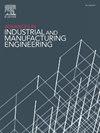Influence of process parameters on single weld seam geometry and process stability in Laser Hot-Wire Cladding of AISI 52100
Abstract
Steels with high carbon content can hardly or not at all be welded, but are of great interest for cladding applications due to their high hardness. In this study, the influence of process parameters on weld seam geometry and process stability is investigated when welding AISI 52100 bearing steel using the laser hot-wire cladding process. Process stability is evaluated using actual and set values for the wire feed rate and current parameters to determine a process window for a stable welding process. Weld seams are measured and analyzed in terms of width, height, contact angle, and shape. The effect of the process parameters on the weld seam geometry is investigated and appropriate mathematical functions to describe the geometry are determined. Process parameter sets in the range of 1-2 m/min wire feed rate and 45-75 A hot wire current were investigated. Unstable parameter sets occur clustered at high wire feed rate of 2 m/min for all hot wire currents. In addition, the process is unstable at high hot wire current of 75 A and low wire feed speed of 1 m/min. The remaining parameter sets resulted in a stable process. The investigated functions parabolic, cosinusoidal and circular arc for the mathematical description of the weld seam geometry, no clearly significant result could be determined. Only a trend towards the circular arc function and the parabolic function is apparent.

 求助内容:
求助内容: 应助结果提醒方式:
应助结果提醒方式:


